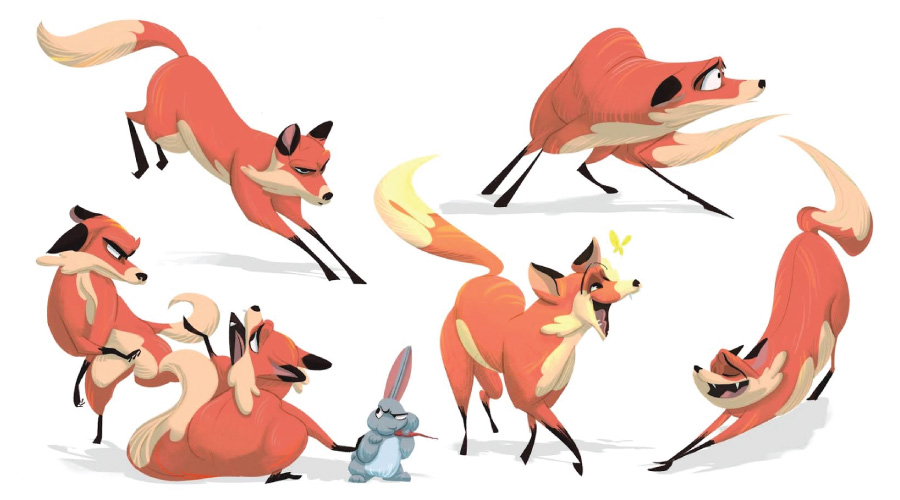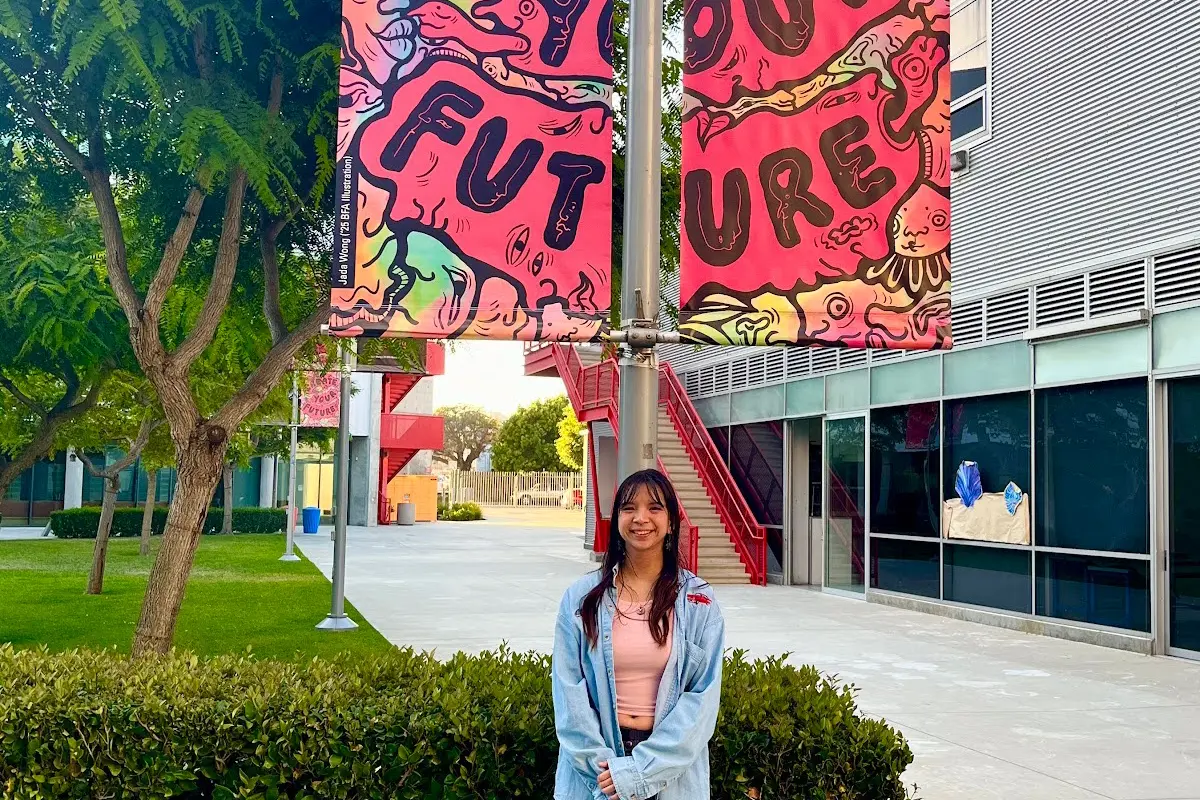Story Artist Jamila Koch (’23 BFA Digital Media, Animation) on How Otis College Prepared Her for a Career in Animation
“Otis is a stepping stone for a professional career in art, but we have to push forward and keep climbing on our own.”

Like many young people growing up in the Los Angeles area, Jamila Koch (’23 BFA Digital Media, Animation) had dreams of becoming a filmmaker. The Sherman Oaks native had her sights set on attending USC or UCLA to learn live action directing before evaluating what she really loved about movies.
“I realized at my core that I love filmmaking and storytelling, not necessarily for live productions,” she says. “I came to the conclusion that I could expand and explore my interests in a digital landscape, so I took the leap into animation and digital storytelling and applied to Otis College.” After getting her start at Netflix as a Story Artist right after graduating—she was a Story Trainee while still in school—she also has worked as a Story Revisionist at Paramount Animation, where she worked on films like The SpongeBob Movie: The Search for Squarepants.
On October 29, 12:30 -1:30 p.m., Jamila will speak on campus about her experiences in animation. In the lead-up to that event, she answered some of our own questions about her life at and after Otis.
When you started at Otis College, did you know what you wanted to do professionally?
Originally I didn’t know what I wanted to pursue in the animation industry. I went in with a broad goal to be a part of that industry in some way. Animation, character design, and visual development, which are the most popular paths in Otis’s [former] Digital Media program, didn’t call to me the way it did my peers. Through research I discovered the world of storyboarding, and committed my time and energy into developing skills for that path.

How do you describe what you do for a living?
A lot of people hear “storyboarding” and don’t really know what it entails. I explain that story artists develop the very first visual pass of the written story—the script—to give creatives a better understanding of what would and wouldn’t work further down the rendering pipeline. We create visual drafts, so a majority of our work doesn’t end up being on screen.
How did you get your first job at Netflix?
I filled the summers between my freshman and junior years with online courses. I signed
up for gesture drawing classes, basics in storyboarding classes, visual development,
character design, landscape design, and applied to more internships and traineeships
than I can recall. I remember staying up late with my roommate creating cover letters,
fine-tuning resumes, and updating portfolios. Right before the start of senior year
I received an email from a Netflix recruiter who wanted to speak to me about the Netflix
Feature Animation Traineeship program. I did a couple rounds of interviews, met with
my potential team, and started as a story trainee two weeks after. It was surreal
and happened so fast. I was incredibly grateful that those late nights and long summers
paid off.

What lesson about working as a story artist do you wish you had learned sooner than you did?
It’s a very fast industry and we don’t have as much luxury of time as some of the other creative roles. Our jobs as story artists are to ideate over and over and over with quick but clear drawings. We complete a sequence, receive notes, implement them, and repeat this process two or more times until it sorta works. And then it goes to editorial and may come back for more notes. If I could go back I’d spend more time ideating quickly rather than perfecting my work so that I could build up that speed.
You also can’t be precious with your work and definitely don’t get emotionally attached to it. It’s never personal, but sometimes work doesn’t align with a lead creative, and that piece you spent a month on gets scrapped in two seconds, and that’s OK.
"I think learning to take critique and utilize rejection as fuel instead of failure will only ever help you in your career."

What is the biggest misconception about being a story artist/revisionist?
My job as a story artist fundamentally has nothing to do with drawing! Yes, our draftsmanship and ability to draw are important, but our job is to think, explore, interpret—that is the product. So a messy drawing but a clear idea is all that matters. From the outside perspective, a single image of a messy drawing seems insignificant out of the context of the entire sequence of messy drawings that reveal a story at its very early stages.
Who are your professional heroes?
My professional heroes are a lot of the friends I made in my time on my previous production and all my trainee peers. Of the professionals I don’t know personally, I’d say Francis Ford Coppola, Tim Burton, Steven Spielberg, Aphton Corbin, Wes Anderson, Alan Menkin, Thomas Newman, and way more than I can list. A lot of these people either faced harsh criticism and “failure” during the early years of their career, became some of the most influential and groundbreaking creators of their time from less than nothing, dared to be different and weird and didn’t change because the world wasn’t ready for them in the beginning, or created the soundtracks that transport me to a magical cinematic world with music that genuinely feels like it comes from and speaks to the soul.
In a time like now, where the industry is in turbulence, jobs are scarce, and creativity
feels like it’s taking more of a backseat to content, their stories give me hope and
make me feel that with time and perseverance I’ll someday be able to make my dreams
come true.

What is your long term ambition?
My goal is to be an animated film director.
I have a million film ideas that I plan to create, filled with multidimensional, relatable, real characters and worlds that feel familiar and personal, and stories that I hope will resonate with people of different backgrounds and circumstances."
I want to make movies more like the action-adventures of my youth—full of risks, real and scary situations, reflections of real life and big emotions. I don’t want to treat children like they’re incapable of understanding complex issues and feelings. My generation was empowered with shows and movies like Avatar: The Last Airbender, The Goonies, The Incredibles, and Spirited Away. I want to create the movies I wanted to watch as a kid, and, by doing so, keep the kid in me alive.
What advice do you have for current Otis students?
Think of class like a warm-up, not a requirement you have to get through. Make every opportunity out of your time at Otis. Supplement your time with outside courses, take a class outside of your major, attend speaker series, do extra credit, work on personal projects, make the most of your summer, explore ideas with your friends. Trust me when I say that you’ll be so grateful to your past self that you did everything you possibly could to prepare yourself for life after Otis.
That being said, not to be contradictory, but make sure to schedule breaks. I didn’t know how important it was until burnout got to me, and I realized not taking breaks actually exhausted me to a point where I had less time to continue learning and practicing in the future. You can miss a gesture sketching session and do it later, but if your body needs a break you need to listen or you won’t have the energy physically or mentally to do anything creative for a good while.
What advice do you have for anyone looking to enter your industry?
I’ve learned it’s less important to be the best at one thing and better to be good at multiple things. Set yourself up to be able to adjust and survive in the industry no matter what it needs at that moment in time. It may feel like giving up on your dreams or even putting them aside, but it’s actually just preparing yourself to keep working within the industry consistently. Diversify your portfolio!
Visit the Animation program at Otis College for more information about this exciting BFA program.
Related News



